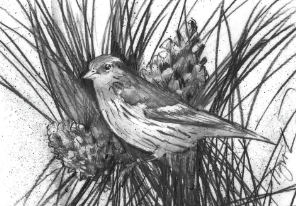
If you are prone to looking up as you walk (or pedal or drive) among trees, you may have noticed a bumper crop of cones clinging to the highest branches of white pine trees this summer and fall. Around my yard, the red squirrels have been busy gathering cones, chattering away as they scamper through the branches. But I’ve also heard another sound this autumn – beyond the scolding squirrels and familiar chickadee calls – a gregarious twittering from high in the trees.
That is the sound of pine siskins, and I’ve heard them prattling – like a group of excited children calling to each other on the playground – from the tall white pines along my walking route near home, the birches at the edge of our field, and the hardwood trees near my office parking spot. These diminutive finches are exceptionally nomadic, and they’re showing up in droves around northern New England this autumn.
Streaky brown, with yellow tinting the edges of tail and wing, pine siskins breed across the northern width of our continent, including in the boreal forests of eastern Canada and in mixed forests in northern New England. Like other nomadic finches, pine siskins follow food sources, often traveling in large flocks. While migratory birds tend to move in north-south patterns, these seed-seekers travel more west-east, although they’ll move as far south as Mexico during winter in search of food.
A poor crop of white spruce cones across the boreal forest this year has meant a large irruption of pine siskins – and other nomadic finches – to our region this fall, according to Tyler Hoar, author of the Finch Research Network’s annual Winter Finch Forecast. They’ve come to nosh on that bumper crop of white pine cones, along with the red crossbills and white-winged crossbills that have traveled here from western North America.
“I’d love to know how these birds can tell from 5,000 miles away that there’s an abundant seed crop,” Hoar said.
However they find that abundance, word is out among the nomads. In the case of pine siskins, it’s not just white pine cones drawing them here. “They’re the Swiss army knife of finches; they’ll eat just about anything,” Hoar said. “Birch seeds are their favorite, and they’ll take any conifer seed they can get.”
Unlike crossbills, whose beaks are uniquely suited to opening cones to access seeds, pine siskins have sharp, pointy bills and prefer cones that have already opened, allowing them to pick the seeds from within. They’ll even hang upside down to access seeds if necessary. Although they prefer to forage in trees and shrubs, pine siskins will also eat seeds of grasses and weeds. And while the spruce seed crop in Canada has been poor this year, pine siskins have feasted on an outbreak of spruce budworm; they’ll eat the eggs, larvae, and adults of that forest pest.
Pine siskin will also visit feeders during the winter – especially those stocked with thistle or nyjer seed – although they’ll stick to wild foods for as long as they can find them. Wherever they’re foraging, they’re likely to be doing so in large, noisy flocks – often in the company of goldfinches, which share similar food preferences.
To survive winter weather, pine siskins pack on the fat, adding considerably more winter fat than similarly sized goldfinches and redpolls. Pine siskins are also able to notch up their metabolism to keep their small bodies warm during the coldest nights. That requires extra energy of course, and these birds use their crop – an expandable pouch near the esophagus – for short term storage of seeds, which they can consume as needed.
How long pine siskins and other nomadic finches stay in an area can depend on the availability of bird feeders. (And a note here to please wait to put out your feeders until the local bears have denned up for the winter!) Many of these birds will establish a regular circuit of bird feeders to visit.
“They’re very entertaining at feeders. They squabble among each other trying to get food,” said Hoar. “Some pine siskins have a greenish tinge to the plumage, so if you get individuals like that at your feeder, you can start to tell them apart. They have personality. They can make a cold, dark, dreary winter day a bit brighter.”
Other irruptive birds that may show up at northern New England feeders this winter include common redpolls and evening grosbeaks. To read the full Winter Finch Forecast, go to finchnetwork.org.
Meghan McCarthy McPhaul is the associate editor of Northern Woodlands. Illustration by Adelaide Murphy Tyrol. The Outside Story is assigned and edited by Northern Woodlands magazine and sponsored by the Wellborn Ecology Fund of the New Hampshire Charitable Foundation:.nhcf.org.



